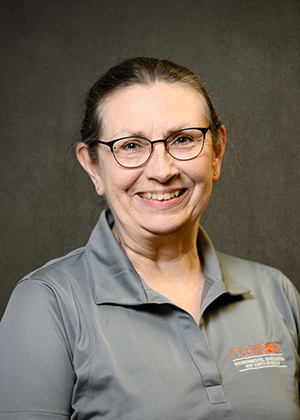Elizabeth Carraway
 Associate Professor
Associate Professor
Environmental Engineering & Earth Sciences
342 Computer Court, Anderson, SC 29625
864.656.5574
E-mail: ecarraw@clemson.edu
Campus Location:
334 Brackett Hall
Clemson, SC 29634
Postdoctoral Research Associate, Environmental Engineering, University of Michigan, 1992-1994
Postdoctoral Fellow, Environmental Engineering Science, California Institute of Technology, 1990-1992
Ph.D. Chemistry, University of Virginia, 1989
B.S. Chemistry, College of Charleston, 1981
Classes | Publications | Honors | CV
Faculty Overview
Dr. Carraway's primary teaching and research interests are environmental chemistry applied to engineered and natural systems. She regularly teaches courses in environmental analytical chemistry and introductory environmental science and periodically teaches courses on photochemistry and on environmental effects of nanomaterials. A common thread in Dr. Carraway’s research activities is the drive to understand nature through a chemist’s eyes – that is, by describing chemical behavior and transformations in the environment. In particular, recurrent themes are oxidation and reduction reactions requiring the interaction of both organic and inorganic species and, frequently, the input of photochemical energy. Past and present research projects include the reduction of contaminants such as chlorinated solvents to innocuous products by micro- and nano-sized zero-valent iron, the effects of complexation of metals (Cu2+, Hg2+) by humic materials on the metal’s toxicity, and the behavior of nanomaterials, including photochemically active semiconductor nanoparticles, in aqueous systems. Current projects emphasize the aquatic behavior of metal-based nanomaterials, the measurement of metal and organic contaminants in South Carolina, and redox reactions of metals assisted by electron shuttles such as metalloporphyrins. The tools needed to complete these studies often require modifications of and new approaches to analytical methods, therefore, good laboratory skills and creative thinking are highly valued. Ultimately, by identifying factors such as important reactants, products, and effects (e.g, adsorption, complexation, catalysis) on reaction rates, we hope to contribute to a better understanding of nature–contaminant remediation & transport, bioavailability & toxicity, and biogeochemical cycles – and to environmental protection, conservation, and restoration.
Class Information
For current syllabi, please search the Clemson University Syllabus Repository.
ENSP 2000 Introduction to Environmental Science
EES 4010/6010 Environmental Engineering
EES 8480 Introduction to Laboratory Procedures and Instrumentation
EES 8490 Environmental Chemistry Laboratory II
ENTX 8220 Analytical Toxicology Laboratory
EES 8830 Selected Topics: Environmental Photochemistry
EES 8830 Selected Topics: Nanotechnology – Environmental Benefits and Concerns
Selected Publications & Presentations
McCourt, K., Sautter, G., Estes, S.L., McMahan, C., Lee, C., Carraway, E.R., Vélez-Torres, I. and Vanegas, D. 2024. Participatory assessment of pollution and health risk in artisanal and small-scale gold mining communities in Colombia. Groundwater for Sustainable Development 25, 101158.
McCourt, K.M., Cochran, J., Abdelbasir, S.M., Carraway, E.R., Tzeng, T.R.J., Tsyusko, O. V., Vanegas, D.C., 2022. Potential Environmental and Health Implications from the Scaled-Up Production and Disposal of Nanomaterials Used in Biosensors. Biosensors 12, 1082. doi:10.3390/BIOS12121082/S1
Langlois, T., Carbajales-Dale, M., and Carraway, E. 2018. Visualizing Relative Potential for Aquatic Ecosystem Toxicity Using the EPA Toxics Release Inventory and Life Cycle Assessment Methods, Journal of South Carolina Water Resources, 5 (1), 2.
Mwaanga, P., Carraway, E.R., Schlautman, M.A., 2014. Preferential sorption of some natural organic matter fractions to titanium dioxide nanoparticles: influence of pH and ionic strength. Environ. Monit. Assess. 186, 8833–8844. doi:10.1007/s10661-014-4047-4
Mwaanga, P., Carraway, E.R., van den Hurk, P., 2014. The induction of biochemical changes in Daphnia magna by CuO and ZnO nanoparticles. Aquat. Toxicol. 150, 201–209. doi:10.1016/j.aquatox.2014.03.011
Carraway, E.R., "Investigating relationships among trace metals in South Carolina streams and land use," 66th Southeastern Regional Meeting of the American Chemical Society (SERMACS), Symposium in Honor of W. Frank Kinard, Nashville, TN, October 2014.
Jones, A.J., Carraway, E.R., Marion, C.A., Scott, M.C., "Trace Metal Concentrations in South Carolina Streams: Statewide, Ecoregion, and Ecobasin Relationships," 248th ACS National Meeting, Symposium in Honor of Frank Kinard, San Francisco, CA, August 2014.
Jones, A., Carraway, E., Marion, C., Scott, M., "Metals concentrations in South Carolina streams: statewide, ecoregion, and ecobasin relationships to land cover," GeoMap Workshop (1st International Workshop on Practical Aspects of Geochemical Exploration and Mapping with Logratio Techniques), Olomouc, Czech Republic, June 2014.
Jones, A.J., Marion, C., Scott, M., Carraway E., "Pharmaceuticals and Personal Care Products in the Environment: Community Responses to Exposure," Carolinas Regional Chapter of SETAC Annual Meeting, Clemson, SC, April 2014.
Mwaanga, P., Carraway, E.R., Schlautman, M.A., "The Dissolution Kinetics of Copper Oxide and Zinc Oxide Nanoparticles in Aqueous Solution: The Role of Aqueous Chemistry," (Poster) SETAC North America 34th Annual Meeting, Nashville, TN, November 2013.
Xu, X., Carraway, E.R., 2012. Sonication-Assisted Synthesis of β-Mercuric Sulphide Nanoparticles. Nanomater. Nanotechnol. 2, 1–6.
Awards & Honors
Clemson University, Board of Trustees Award for Faculty Excellence (2006)
National Science Foundation, Early CAREER Award (1999)

